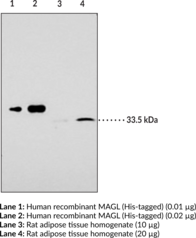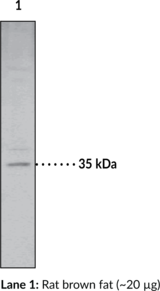Cayman
Showing 30151–30300 of 45550 results
-
Monastrol is a reversible, cell-permeable inhibitor of the motor protein Eg5 (kinesin family protein 11, Kif11), blocking basal ATPase activity in vitro (IC50 = 6.1 µM) and inducing the formation of monoastral spindles in cell-based assays (IC50 = 51.3 μM).{8354,24107} It arrests cells in mitosis without targeting tubulin and, as a result, does not interfere with microtubule dependent processes.{24106} Monastrol induces activation of the spindle assembly checkpoint and the resulting mitotic arrest can lead to cell death in certain tumor cell lines.{22151}
Brand:CaymanSKU:-Monastrol is a reversible, cell-permeable inhibitor of the motor protein Eg5 (kinesin family protein 11, Kif11), blocking basal ATPase activity in vitro (IC50 = 6.1 µM) and inducing the formation of monoastral spindles in cell-based assays (IC50 = 51.3 μM).{8354,24107} It arrests cells in mitosis without targeting tubulin and, as a result, does not interfere with microtubule dependent processes.{24106} Monastrol induces activation of the spindle assembly checkpoint and the resulting mitotic arrest can lead to cell death in certain tumor cell lines.{22151}
Brand:CaymanSKU:-Monastrol is a reversible, cell-permeable inhibitor of the motor protein Eg5 (kinesin family protein 11, Kif11), blocking basal ATPase activity in vitro (IC50 = 6.1 µM) and inducing the formation of monoastral spindles in cell-based assays (IC50 = 51.3 μM).{8354,24107} It arrests cells in mitosis without targeting tubulin and, as a result, does not interfere with microtubule dependent processes.{24106} Monastrol induces activation of the spindle assembly checkpoint and the resulting mitotic arrest can lead to cell death in certain tumor cell lines.{22151}
Brand:CaymanSKU:-Monazomycin is a macrocyclic polyol lactone first isolated from Streptoverticillium that is active against Gram-positive bacteria. In solution, monazomycin exists as hydrophilic clusters that, when adsorbed onto a lipid bilayer, can induce voltage-dependent conductance.{32126,32127}
Brand:CaymanSKU:20589 -Available on backorder
Monazomycin is a macrocyclic polyol lactone first isolated from Streptoverticillium that is active against Gram-positive bacteria. In solution, monazomycin exists as hydrophilic clusters that, when adsorbed onto a lipid bilayer, can induce voltage-dependent conductance.{32126,32127}
Brand:CaymanSKU:20589 -Available on backorder
Monensin is a naturally occuring ionophorous antibiotic that preferentially forms complexes with monovalent cations to enable transport across lipid membranes.{26941} Through its ability to affect pH and the sodium-potassium balance of a cell, monensin can induce cell death in Gram-positive bacteria such as Micrococcus, Bacillus, and Staphylococcus (MICs = 1-12.5 µg/ml), reduce proliferation of P. falciparum and Coccicdium protozoa, and also prevent replication of certain viruses.{26941}
Brand:CaymanSKU:-Out of stock
Monensin is a naturally occuring ionophorous antibiotic that preferentially forms complexes with monovalent cations to enable transport across lipid membranes.{26941} Through its ability to affect pH and the sodium-potassium balance of a cell, monensin can induce cell death in Gram-positive bacteria such as Micrococcus, Bacillus, and Staphylococcus (MICs = 1-12.5 µg/ml), reduce proliferation of P. falciparum and Coccicdium protozoa, and also prevent replication of certain viruses.{26941}
Brand:CaymanSKU:-Out of stock
Monensin is a naturally occuring ionophorous antibiotic that preferentially forms complexes with monovalent cations to enable transport across lipid membranes.{26941} Through its ability to affect pH and the sodium-potassium balance of a cell, monensin can induce cell death in Gram-positive bacteria such as Micrococcus, Bacillus, and Staphylococcus (MICs = 1-12.5 µg/ml), reduce proliferation of P. falciparum and Coccicdium protozoa, and also prevent replication of certain viruses.{26941}
Brand:CaymanSKU:-Out of stock
Monensin is a naturally occuring ionophorous antibiotic that preferentially forms complexes with monovalent cations to enable transport across lipid membranes.{26941} Through its ability to affect pH and the sodium-potassium balance of a cell, monensin can induce cell death in Gram-positive bacteria such as Micrococcus, Bacillus, and Staphylococcus (MICs = 1-12.5 µg/ml), reduce proliferation of P. falciparum and Coccicdium protozoa, and also prevent replication of certain viruses.{26941}
Brand:CaymanSKU:-Out of stock
Moniliformin is a mycotoxin produced by fungi of the Fusarium genus that are common pathogens to corn and other agriculture grain crops.{28918} Its phytotoxicity results from inducing mitotic arrest at the metaphase stage.{27463} Moniliformin has been shown to be cardiotoxic to poultry and rats and cytotoxic to human red blood cell progenitors with an IC50 value of 4.1 μM.{28919,28920}
Brand:CaymanSKU:-Available on backorder
MONNA is a selective inhibitor of anoctamin-1 (ANO1; IC50 = 0.08 µM in Xenopus oocytes), a calcium-activated chloride channel (CaCC).{34636} It is selective for ANO1 over the chloride channels bestrophin-1, chloride channel protein 2, and cystic fibrosis transmembrane conductance regulator up to 10 µM. MONNA (10 µM) induces full vasorelaxation of preconstricted mouse isolated mesenteric arteries in the presence or absence of chloride.{34635} It also hyperpolarizes isolated rat mesenteric arteries under resting conditions.
Brand:CaymanSKU:21917 -Out of stock
MONNA is a selective inhibitor of anoctamin-1 (ANO1; IC50 = 0.08 µM in Xenopus oocytes), a calcium-activated chloride channel (CaCC).{34636} It is selective for ANO1 over the chloride channels bestrophin-1, chloride channel protein 2, and cystic fibrosis transmembrane conductance regulator up to 10 µM. MONNA (10 µM) induces full vasorelaxation of preconstricted mouse isolated mesenteric arteries in the presence or absence of chloride.{34635} It also hyperpolarizes isolated rat mesenteric arteries under resting conditions.
Brand:CaymanSKU:21917 -Out of stock
MONNA is a selective inhibitor of anoctamin-1 (ANO1; IC50 = 0.08 µM in Xenopus oocytes), a calcium-activated chloride channel (CaCC).{34636} It is selective for ANO1 over the chloride channels bestrophin-1, chloride channel protein 2, and cystic fibrosis transmembrane conductance regulator up to 10 µM. MONNA (10 µM) induces full vasorelaxation of preconstricted mouse isolated mesenteric arteries in the presence or absence of chloride.{34635} It also hyperpolarizes isolated rat mesenteric arteries under resting conditions.
Brand:CaymanSKU:21917 -Out of stock
MONNA is a selective inhibitor of anoctamin-1 (ANO1; IC50 = 0.08 µM in Xenopus oocytes), a calcium-activated chloride channel (CaCC).{34636} It is selective for ANO1 over the chloride channels bestrophin-1, chloride channel protein 2, and cystic fibrosis transmembrane conductance regulator up to 10 µM. MONNA (10 µM) induces full vasorelaxation of preconstricted mouse isolated mesenteric arteries in the presence or absence of chloride.{34635} It also hyperpolarizes isolated rat mesenteric arteries under resting conditions.
Brand:CaymanSKU:21917 -Out of stock
Immunogen: Purified recombinant human MAGL • Host: Rabbit • Species Reactivity: (+) Human and rat; other species not tested • Applications: ICC, IHC, and WB
Brand:CaymanSKU:10212- 500 µgEndocannabinoids, such as arachidonoyl ethanolamide (AEA) and 2-arachidonoyl glycerol (2-AG), function as short-range modulators of cell and synaptic activity. Monoacylglycerol lipase (MAGL) hydrolyzes 2-AG to terminate its biological actions and works consecutively with hormone-sensitive lipase to mobilize fatty acids from the triglyceride stores of adipocytes.{11364,11436} MAGL has a molecular weight of ~33 kDa and exhibits a high degree of homology among human, murine, and rat at the amino acid level.{11364,11436, 5105,10671} The enzyme is expressed in a variety of tissues with most abundant expression in skeletal muscle and adipose tissue, suggesting a role of MAGL in monoglyceride hydrolysis in diverse tissues. Cayman’s MAGL (FL) Polyclonal Antibody can be used for Western blot, immunocytochemistry, and immunohistochemistry analysis for MAGL.
Brand:CaymanSKU:10212 - 500 µgAvailable on backorder
Immunogen: Purified recombinant human MAGL • Host: Rabbit • Species Reactivity: (+) Human and rat; other species not tested • Applications: ICC, IHC, and WB
Brand:CaymanSKU:10212- 500 µgAvailable on backorder
Endocannabinoids such as 2-arachidonoyl glycerol (2-AG; Item No. 62160) and arachidonoyl ethanolamide (AEA; Item No. 90050) are biologically active lipids that are involved in a number of synaptic processes including activation of cannabinoid (CB) receptors. Fatty acid amide hydrolase (FAAH) and monoacylglycerol lipase (MAGL) mediate the hydrolysis of AEA and 2-AG, respectively. MAGL inhibitor 21 selectively binds to MAGL (Ki = 0.4 µM) and reversibly blocks the enzyme’s activity in mouse brain with an IC50 value of 0.18 µM.{27369} Comparatively, MAGL inhibitor 21 is reported to inhibit FAAH activity in mouse brain with an IC50 value of 59 µM.{37369} This compound does not bind CB1 or CB2 receptors and does not inhibit the related serine hydrolases ABHD6 and ABHD12 (Kis > 10 µM).{27369} In a mouse model of multiple sclerosis, 5 mg/kg of MAGL inhibitor 21 has been used to ameliorate progression of the disease without producing detrimental CB1-mediated effects.{27369}
Brand:CaymanSKU:-Out of stock
Endocannabinoids such as 2-arachidonoyl glycerol (2-AG; Item No. 62160) and arachidonoyl ethanolamide (AEA; Item No. 90050) are biologically active lipids that are involved in a number of synaptic processes including activation of cannabinoid (CB) receptors. Fatty acid amide hydrolase (FAAH) and monoacylglycerol lipase (MAGL) mediate the hydrolysis of AEA and 2-AG, respectively. MAGL inhibitor 21 selectively binds to MAGL (Ki = 0.4 µM) and reversibly blocks the enzyme’s activity in mouse brain with an IC50 value of 0.18 µM.{27369} Comparatively, MAGL inhibitor 21 is reported to inhibit FAAH activity in mouse brain with an IC50 value of 59 µM.{37369} This compound does not bind CB1 or CB2 receptors and does not inhibit the related serine hydrolases ABHD6 and ABHD12 (Kis > 10 µM).{27369} In a mouse model of multiple sclerosis, 5 mg/kg of MAGL inhibitor 21 has been used to ameliorate progression of the disease without producing detrimental CB1-mediated effects.{27369}
Brand:CaymanSKU:-Out of stock
Endocannabinoids such as 2-arachidonoyl glycerol (2-AG; Item No. 62160) and arachidonoyl ethanolamide (AEA; Item No. 90050) are biologically active lipids that are involved in a number of synaptic processes including activation of cannabinoid (CB) receptors. Fatty acid amide hydrolase (FAAH) and monoacylglycerol lipase (MAGL) mediate the hydrolysis of AEA and 2-AG, respectively. MAGL inhibitor 21 selectively binds to MAGL (Ki = 0.4 µM) and reversibly blocks the enzyme’s activity in mouse brain with an IC50 value of 0.18 µM.{27369} Comparatively, MAGL inhibitor 21 is reported to inhibit FAAH activity in mouse brain with an IC50 value of 59 µM.{37369} This compound does not bind CB1 or CB2 receptors and does not inhibit the related serine hydrolases ABHD6 and ABHD12 (Kis > 10 µM).{27369} In a mouse model of multiple sclerosis, 5 mg/kg of MAGL inhibitor 21 has been used to ameliorate progression of the disease without producing detrimental CB1-mediated effects.{27369}
Brand:CaymanSKU:-Out of stock
Endocannabinoids such as 2-arachidonoyl glycerol (2-AG; Item No. 62160) and arachidonoyl ethanolamide (AEA; Item No. 90050) are biologically active lipids that are involved in a number of synaptic processes including activation of cannabinoid (CB) receptors. Fatty acid amide hydrolase (FAAH) and monoacylglycerol lipase (MAGL) mediate the hydrolysis of AEA and 2-AG, respectively. MAGL inhibitor 21 selectively binds to MAGL (Ki = 0.4 µM) and reversibly blocks the enzyme’s activity in mouse brain with an IC50 value of 0.18 µM.{27369} Comparatively, MAGL inhibitor 21 is reported to inhibit FAAH activity in mouse brain with an IC50 value of 59 µM.{37369} This compound does not bind CB1 or CB2 receptors and does not inhibit the related serine hydrolases ABHD6 and ABHD12 (Kis > 10 µM).{27369} In a mouse model of multiple sclerosis, 5 mg/kg of MAGL inhibitor 21 has been used to ameliorate progression of the disease without producing detrimental CB1-mediated effects.{27369}
Brand:CaymanSKU:-Out of stock
The endocannabinoid system is a ubiquitous lipid signaling system that is involved in various regulatory functions throughout the body. The main endocannabinoids are arachidonoyl ethanolamide (AEA) and 2-arachidonoyl glycerol (2-AG). They bind to G protein-coupled receptors, of which the cannabinoid (CB1) receptor is densely distributed in areas of the brain related to motor control, cognition, emotional responses, and homeostasis.{7183,4614,6819,14061} Acting via the CB2 receptor in the peripheral tissues, the endocannabinoid system is one of the crucial modulators of the autonomic nervous system, the immune system, and microcirculation. Endocannabinoids are released upon demand from lipid precursors in a receptor-dependent manner. They are transported into cells by an apparently specific uptake system and degraded primarily by two enzymes, fatty acid amide hydrolase (FAAH) and monoacylglycerol lipase (MAGL) resulting in the termination of their biological actions.{11364} FAAH, a serine hydrolase, can degrade many fatty acid amides, including AEA. Although FAAH can hydrolyze 2-AG, the main enzyme responsible for the inactivation of this monoglyceride is another serine hydrolase, MAGL. Finding inhibitors to these endocannabinoid hydrolases could offer another approach in the treatment of pain, obesity, and various neurological diseases, where higher endocannabinoid activity would be beneficial. An advantage of such enzyme inhibition over direct cannabinoid agonists could result in higher selectivity, as it would increase activity of the endocannabinoid system only at sites where on-going production of endocannabinoids is taking place.{14062} Cayman’s Monoacylglycerol Lipase Inhibitor Screening Assay provides a convenient method for screening human MAGL inhibitors. MAGL hydrolyzes 4-nitrophenylacetate resulting in a yellow product, 4-nitrophenol, with an absorbance of 405-412 nm.{16685}
Brand:CaymanSKU:705192 - 96 wellsAvailable on backorder
Immunogen: Synthetic peptide from human MAGL • Species Reactivity: (+) Human, bovine, mouse, and rat • Host: Rabbit • Applications: IHC (formalin-fixed paraffin-embedded tissue) and WB
Brand:CaymanSKU:100035- 1 eaAvailable on backorder
Immunogen: Synthetic peptide from human MAGL • Species Reactivity: (+) Human, bovine, mouse, and rat • Host: Rabbit • Applications: IHC (formalin-fixed paraffin-embedded tissue) and WB
Brand:CaymanSKU:100035- 1 eaEndocannabinoids, such as arachidonoyl ethanolamide (AEA) and 2-Arachidonoyl glycerol (2-AG), function as short-range modulators of cell and synaptic activity. Monoacylglycerol lipase (MAGL) hydrolyzes 2-AG to terminate its biological actions and works consecutively with hormone-sensitive lipase (HSL) to mobilize fatty acids from the triglyceride stores of adipocytes.{11364,11436} MAGL has a molecular weight of ~33 kDa and exhibits a high degree of homology among human, mouse, and rat at the amino acid level.{11364,11436,5105,10671} The enzyme is expressed in a variety of tissues with most abundant expression in skeletal muscle and adipose tissue, suggesting a role of MAGL in monoglyceride hydrolysis in diverse tissues. Cayman Chemical’s MAGL polyclonal antibody can be used for western blot and immunohistochemical (formalin-fixed paraffin-embedded tissue) analysis for MAGL on samples of human, mouse, rat, and bovine origin. Other applications for use of this antibody have not yet been tested.
Brand:CaymanSKU:100035 - 1 eaAvailable on backorder
Monobromobimane is a thiol-reactive fluorogenic probe. It is cell-permeable, reacts rapidly at physiological pH with available thiol groups, and generates a stable fluorescent signal.{27960} Monobromobimane can be used to evaluate or quantify a variety of compounds containing reactive sulfur or thiol groups, including H2S, glutathione, proteins, and nucleotides.{27959,18717,27961,27958} The absorption and emission maxima for monobromobimane are 398 and 490 nm, respectively.{22804}
Brand:CaymanSKU:-Out of stock
Monobromobimane is a thiol-reactive fluorogenic probe. It is cell-permeable, reacts rapidly at physiological pH with available thiol groups, and generates a stable fluorescent signal.{27960} Monobromobimane can be used to evaluate or quantify a variety of compounds containing reactive sulfur or thiol groups, including H2S, glutathione, proteins, and nucleotides.{27959,18717,27961,27958} The absorption and emission maxima for monobromobimane are 398 and 490 nm, respectively.{22804}
Brand:CaymanSKU:-Out of stock
Monobromobimane is a thiol-reactive fluorogenic probe. It is cell-permeable, reacts rapidly at physiological pH with available thiol groups, and generates a stable fluorescent signal.{27960} Monobromobimane can be used to evaluate or quantify a variety of compounds containing reactive sulfur or thiol groups, including H2S, glutathione, proteins, and nucleotides.{27959,18717,27961,27958} The absorption and emission maxima for monobromobimane are 398 and 490 nm, respectively.{22804}
Brand:CaymanSKU:-Out of stock
Monobromobimane is a thiol-reactive fluorogenic probe. It is cell-permeable, reacts rapidly at physiological pH with available thiol groups, and generates a stable fluorescent signal.{27960} Monobromobimane can be used to evaluate or quantify a variety of compounds containing reactive sulfur or thiol groups, including H2S, glutathione, proteins, and nucleotides.{27959,18717,27961,27958} The absorption and emission maxima for monobromobimane are 398 and 490 nm, respectively.{22804}
Brand:CaymanSKU:-Out of stock
Monocerin is a fungal metabolite that has been found in F. larvarum and has diverse biological activities.{53561,53562,53563} It is active against the bacteria E. coli and B. megaterium, the phytopathogenic fungus M. violaceum, and the alga C. fusca in an agar diffusion assay when used at a concentration of 50 µg/disc.{53561} Monocerin (17.5 µg/ml) induces mortality in adult C. erythrocephala.{53562} It reduces root elongation in pre-germinated S. halepense seeds when used at a concentration of 33 ppm.{53563}
Brand:CaymanSKU:29572 - 1 mgAvailable on backorder
Monocrotaline is a natural 11-membered macrocyclic pyrrolizidine alkaloid used in an animal model of pulmonary hypertension.{27325,27324} It is metabolized by cytochrome P450 3A4 in the liver to monocrotaline pyrrole. Administration of monocrotaline or its metabolite monocrotaline pyrrole to rats causes progressive lung injury featuring pulmonary vascular remodeling, pulmonary hypertension, and compensatory right heart hypertrophy.{27325,27324}
Brand:CaymanSKU:-Out of stock
Monocrotaline is a natural 11-membered macrocyclic pyrrolizidine alkaloid used in an animal model of pulmonary hypertension.{27325,27324} It is metabolized by cytochrome P450 3A4 in the liver to monocrotaline pyrrole. Administration of monocrotaline or its metabolite monocrotaline pyrrole to rats causes progressive lung injury featuring pulmonary vascular remodeling, pulmonary hypertension, and compensatory right heart hypertrophy.{27325,27324}
Brand:CaymanSKU:-Out of stock
Monocrotaline is a natural 11-membered macrocyclic pyrrolizidine alkaloid used in an animal model of pulmonary hypertension.{27325,27324} It is metabolized by cytochrome P450 3A4 in the liver to monocrotaline pyrrole. Administration of monocrotaline or its metabolite monocrotaline pyrrole to rats causes progressive lung injury featuring pulmonary vascular remodeling, pulmonary hypertension, and compensatory right heart hypertrophy.{27325,27324}
Brand:CaymanSKU:-Out of stock
Monocrotaline is a natural 11-membered macrocyclic pyrrolizidine alkaloid used in an animal model of pulmonary hypertension.{27325,27324} It is metabolized by cytochrome P450 3A4 in the liver to monocrotaline pyrrole. Administration of monocrotaline or its metabolite monocrotaline pyrrole to rats causes progressive lung injury featuring pulmonary vascular remodeling, pulmonary hypertension, and compensatory right heart hypertrophy.{27325,27324}
Brand:CaymanSKU:-Out of stock
Monodansylcadaverine (MDC) is a fluorescent marker for autophagic vacuoles.{17214,48026} It is an autofluorescent substance incorporated into multilamellar bodies by both an ion trapping mechanism and interaction with membrane lipids, exhibiting a Stokes shift and increased relative fluorescence in hydrophobic environments.{17214} MDC selectively accumulates in PaTu 8902 subcellular fractions containing the lysosomal enzymes acid phosphatase and cathepsin D, but not those containing the rough and smooth endoplasmic reticulum markers TRAM and cytochrome P450, respectively.{48026}
Brand:CaymanSKU:-Monodansylcadaverine (MDC) is a fluorescent marker for autophagic vacuoles.{17214,48026} It is an autofluorescent substance incorporated into multilamellar bodies by both an ion trapping mechanism and interaction with membrane lipids, exhibiting a Stokes shift and increased relative fluorescence in hydrophobic environments.{17214} MDC selectively accumulates in PaTu 8902 subcellular fractions containing the lysosomal enzymes acid phosphatase and cathepsin D, but not those containing the rough and smooth endoplasmic reticulum markers TRAM and cytochrome P450, respectively.{48026}
Brand:CaymanSKU:-Monodansylcadaverine (MDC) is a fluorescent marker for autophagic vacuoles.{17214,48026} It is an autofluorescent substance incorporated into multilamellar bodies by both an ion trapping mechanism and interaction with membrane lipids, exhibiting a Stokes shift and increased relative fluorescence in hydrophobic environments.{17214} MDC selectively accumulates in PaTu 8902 subcellular fractions containing the lysosomal enzymes acid phosphatase and cathepsin D, but not those containing the rough and smooth endoplasmic reticulum markers TRAM and cytochrome P450, respectively.{48026}
Brand:CaymanSKU:-Monodansylcadaverine (MDC) is a fluorescent marker for autophagic vacuoles.{17214,48026} It is an autofluorescent substance incorporated into multilamellar bodies by both an ion trapping mechanism and interaction with membrane lipids, exhibiting a Stokes shift and increased relative fluorescence in hydrophobic environments.{17214} MDC selectively accumulates in PaTu 8902 subcellular fractions containing the lysosomal enzymes acid phosphatase and cathepsin D, but not those containing the rough and smooth endoplasmic reticulum markers TRAM and cytochrome P450, respectively.{48026}
Brand:CaymanSKU:-Monogalactosyldiacylglyceride is a minor galactolipid present in oligodendrocytes and myelin, as well as comprises a major fraction of the lipids in photosynthesizing plants and green microorganisms.{29252,29251} It is used as a marker for myelination and has also been shown to stimulate PKCα activity in oligodendrocytes.{29252} Monogalactosyldiacylglyceride mixture contains monogalactosyldiacylglyceride molecular species with C18:0 and C16:0 side chains at a 3:1 ratio. [Matreya, LLC. Catalog No. 1058]
Brand:CaymanSKU:-Available on backorder
Monogalactosyldiacylglyceride is a minor galactolipid present in oligodendrocytes and myelin, as well as comprises a major fraction of the lipids in photosynthesizing plants and green microorganisms.{29252,29251} It is used as a marker for myelination and has also been shown to stimulate PKCα activity in oligodendrocytes.{29252} Monogalactosyldiacylglyceride mixture contains monogalactosyldiacylglyceride molecular species with C18:0 and C16:0 side chains at a 3:1 ratio. [Matreya, LLC. Catalog No. 1058]
Brand:CaymanSKU:-Available on backorder
Monogalactosyldiacylglyceride is a minor galactolipid present in oligodendrocytes and myelin, as well as comprises a major fraction of the lipids in photosynthesizing plants and green microorganisms.{29252,29251} It is used as a marker for myelination and has also been shown to stimulate PKCα activity in oligodendrocytes.{29252} Monogalactosyldiacylglyceride mixture contains monogalactosyldiacylglyceride molecular species with C18:0 and C16:0 side chains at a 3:1 ratio. [Matreya, LLC. Catalog No. 1058]
Brand:CaymanSKU:-Available on backorder
Dolastatin 10 is a natural antimitotic and antineoplastic agent that binds to tubulin and inhibits tubulin polymerization.{28232} Monomethyl Auristatin E (MMAE) is a synthetic analog of dolastatin 10 that similarly inhibits tubulin polymerization and exhibits potent cytotoxicity. It is commonly conjugated with monoclonal antibodies directed at antigens specific to cancer cells for tumor-directed cytotoxicity.{28971,28972} MMAE is typically coupled to the antibody via a protease-cleavable linker, allowing separation of the drug from the antibody following intracellular localization.{28972,28973}
Brand:CaymanSKU:-Dolastatin 10 is a natural antimitotic and antineoplastic agent that binds to tubulin and inhibits tubulin polymerization.{28232} Monomethyl Auristatin E (MMAE) is a synthetic analog of dolastatin 10 that similarly inhibits tubulin polymerization and exhibits potent cytotoxicity. It is commonly conjugated with monoclonal antibodies directed at antigens specific to cancer cells for tumor-directed cytotoxicity.{28971,28972} MMAE is typically coupled to the antibody via a protease-cleavable linker, allowing separation of the drug from the antibody following intracellular localization.{28972,28973}
Brand:CaymanSKU:-Dolastatin 10 is a natural antimitotic and antineoplastic agent that binds to tubulin and inhibits tubulin polymerization.{28232} Monomethyl Auristatin E (MMAE) is a synthetic analog of dolastatin 10 that similarly inhibits tubulin polymerization and exhibits potent cytotoxicity. It is commonly conjugated with monoclonal antibodies directed at antigens specific to cancer cells for tumor-directed cytotoxicity.{28971,28972} MMAE is typically coupled to the antibody via a protease-cleavable linker, allowing separation of the drug from the antibody following intracellular localization.{28972,28973}
Brand:CaymanSKU:-Dolastatin 10 is a natural antimitotic and antineoplastic agent that binds to tubulin and inhibits tubulin polymerization.{28232} Monomethyl Auristatin E (MMAE) is a synthetic analog of dolastatin 10 that similarly inhibits tubulin polymerization and exhibits potent cytotoxicity. It is commonly conjugated with monoclonal antibodies directed at antigens specific to cancer cells for tumor-directed cytotoxicity.{28971,28972} MMAE is typically coupled to the antibody via a protease-cleavable linker, allowing separation of the drug from the antibody following intracellular localization.{28972,28973}
Brand:CaymanSKU:-Monomethyl fumarate is an active metabolite of the immune modulator dimethyl fumarate (Item No. 14714) that is rapidly formed from dimethyl fumarate by hydrolysis.{46318} It is an agonist of the hydroxycarboxylic acid 2 (HCA2) receptor/GPR109A with an EC50 value of 9.4 µM for inducing calcium accumulation in CHO cells expressing the receptor.{46319} Monomethyl fumarate reduces neutrophil adhesion to endothelial cells stimulated with TNF, decreases CXCL2-directed neutrophil migration, and increases the expression of the Nrf2 target gene NQO1 in wild-type but not HCA2-/- macrophages.{46320} It inhibits proliferation and induces differentiation in keratinocytes, as well as decreases the levels of TNF-α induced by phorbol 12-myristate 13-acetate (TPA; Item No. 10008014) in keratinocytes when used at a concentration of 1 mM.{46321} Monomethyl fumarate (1 mg/day) reduces symptoms of experimental autoimmune encephalomyelitis (EAE) in mice and isolated natural killer cells from these mice induced cytotoxicity in previously isolated immature and mature dendritic cells.{46322} Formulations containing monomethyl fumarate have been used in the treatment of multiple sclerosis.
Brand:CaymanSKU:27813 - 10 gAvailable on backorder
Monomethyl fumarate is an active metabolite of the immune modulator dimethyl fumarate (Item No. 14714) that is rapidly formed from dimethyl fumarate by hydrolysis.{46318} It is an agonist of the hydroxycarboxylic acid 2 (HCA2) receptor/GPR109A with an EC50 value of 9.4 µM for inducing calcium accumulation in CHO cells expressing the receptor.{46319} Monomethyl fumarate reduces neutrophil adhesion to endothelial cells stimulated with TNF, decreases CXCL2-directed neutrophil migration, and increases the expression of the Nrf2 target gene NQO1 in wild-type but not HCA2-/- macrophages.{46320} It inhibits proliferation and induces differentiation in keratinocytes, as well as decreases the levels of TNF-α induced by phorbol 12-myristate 13-acetate (TPA; Item No. 10008014) in keratinocytes when used at a concentration of 1 mM.{46321} Monomethyl fumarate (1 mg/day) reduces symptoms of experimental autoimmune encephalomyelitis (EAE) in mice and isolated natural killer cells from these mice induced cytotoxicity in previously isolated immature and mature dendritic cells.{46322} Formulations containing monomethyl fumarate have been used in the treatment of multiple sclerosis.
Brand:CaymanSKU:27813 - 100 gAvailable on backorder
Monomethyl fumarate is an active metabolite of the immune modulator dimethyl fumarate (Item No. 14714) that is rapidly formed from dimethyl fumarate by hydrolysis.{46318} It is an agonist of the hydroxycarboxylic acid 2 (HCA2) receptor/GPR109A with an EC50 value of 9.4 µM for inducing calcium accumulation in CHO cells expressing the receptor.{46319} Monomethyl fumarate reduces neutrophil adhesion to endothelial cells stimulated with TNF, decreases CXCL2-directed neutrophil migration, and increases the expression of the Nrf2 target gene NQO1 in wild-type but not HCA2-/- macrophages.{46320} It inhibits proliferation and induces differentiation in keratinocytes, as well as decreases the levels of TNF-α induced by phorbol 12-myristate 13-acetate (TPA; Item No. 10008014) in keratinocytes when used at a concentration of 1 mM.{46321} Monomethyl fumarate (1 mg/day) reduces symptoms of experimental autoimmune encephalomyelitis (EAE) in mice and isolated natural killer cells from these mice induced cytotoxicity in previously isolated immature and mature dendritic cells.{46322} Formulations containing monomethyl fumarate have been used in the treatment of multiple sclerosis.
Brand:CaymanSKU:27813 - 250 gAvailable on backorder
Monomethyl fumarate is an active metabolite of the immune modulator dimethyl fumarate (Item No. 14714) that is rapidly formed from dimethyl fumarate by hydrolysis.{46318} It is an agonist of the hydroxycarboxylic acid 2 (HCA2) receptor/GPR109A with an EC50 value of 9.4 µM for inducing calcium accumulation in CHO cells expressing the receptor.{46319} Monomethyl fumarate reduces neutrophil adhesion to endothelial cells stimulated with TNF, decreases CXCL2-directed neutrophil migration, and increases the expression of the Nrf2 target gene NQO1 in wild-type but not HCA2-/- macrophages.{46320} It inhibits proliferation and induces differentiation in keratinocytes, as well as decreases the levels of TNF-α induced by phorbol 12-myristate 13-acetate (TPA; Item No. 10008014) in keratinocytes when used at a concentration of 1 mM.{46321} Monomethyl fumarate (1 mg/day) reduces symptoms of experimental autoimmune encephalomyelitis (EAE) in mice and isolated natural killer cells from these mice induced cytotoxicity in previously isolated immature and mature dendritic cells.{46322} Formulations containing monomethyl fumarate have been used in the treatment of multiple sclerosis.
Brand:CaymanSKU:27813 - 50 gAvailable on backorder
Monomethylsulochrin is a fungal metabolite that has been found in Rhizoctonia.{52312} It is active against H. pylori (MIC = 10 µg/ml).
Brand:CaymanSKU:29942 - 2.5 mgAvailable on backorder
Monomethylsulochrin is a fungal metabolite that has been found in Rhizoctonia.{52312} It is active against H. pylori (MIC = 10 µg/ml).
Brand:CaymanSKU:29942 - 500 µgAvailable on backorder
Monotropein is an iridoid glycoside originally isolated from M. officinalis roots and has diverse biological activities.{46362,46363,46364,46365,46366} It increases cell viability and migration of bone marrow-derived endothelial progenitor cells (BM-EPCs) when used at concentrations ranging from 0.1 to 1,000 μM.{46362} Monotropein inhibits apoptosis and reduces levels of matrix metalloproteinase-3 (MMP-3) and MMP-13 in chondrocytes.{46363} It inhibits LPS-induced nuclear translocation of NF-κB and reduces COX-2, inducible nitric oxide synthase (iNOS), TNF-α, and IL-1β mRNA expression in RAW 264.7 cells.{46364} Monotropein (100 and 200 mg/kg) reduces colonic myeloperoxidase (MPO) activity, COX-2 and iNOS mRNA expression, and disease severity in a mouse model of ulcerative colitis induced by dextran sulfate sodium (DSS; Item No. 23250). It increases bone mineral content, bone mineral density, and improves bone microstructure in ovariectomized mice when administered at doses of 40 or 80 mg/kg.{46365} Monotropein (20 and 30 mg/kg) reduces acetic acid-induced writhing in mice and carrageenan-induced paw edema in rats.{46366} It also decreases macrophage infiltration and wound healing time and increases blood vessel formation in a rat model of wound healing.{46362}
Brand:CaymanSKU:27595 - 10 mgAvailable on backorder
Monotropein is an iridoid glycoside originally isolated from M. officinalis roots and has diverse biological activities.{46362,46363,46364,46365,46366} It increases cell viability and migration of bone marrow-derived endothelial progenitor cells (BM-EPCs) when used at concentrations ranging from 0.1 to 1,000 μM.{46362} Monotropein inhibits apoptosis and reduces levels of matrix metalloproteinase-3 (MMP-3) and MMP-13 in chondrocytes.{46363} It inhibits LPS-induced nuclear translocation of NF-κB and reduces COX-2, inducible nitric oxide synthase (iNOS), TNF-α, and IL-1β mRNA expression in RAW 264.7 cells.{46364} Monotropein (100 and 200 mg/kg) reduces colonic myeloperoxidase (MPO) activity, COX-2 and iNOS mRNA expression, and disease severity in a mouse model of ulcerative colitis induced by dextran sulfate sodium (DSS; Item No. 23250). It increases bone mineral content, bone mineral density, and improves bone microstructure in ovariectomized mice when administered at doses of 40 or 80 mg/kg.{46365} Monotropein (20 and 30 mg/kg) reduces acetic acid-induced writhing in mice and carrageenan-induced paw edema in rats.{46366} It also decreases macrophage infiltration and wound healing time and increases blood vessel formation in a rat model of wound healing.{46362}
Brand:CaymanSKU:27595 - 25 mgAvailable on backorder
Monotropein is an iridoid glycoside originally isolated from M. officinalis roots and has diverse biological activities.{46362,46363,46364,46365,46366} It increases cell viability and migration of bone marrow-derived endothelial progenitor cells (BM-EPCs) when used at concentrations ranging from 0.1 to 1,000 μM.{46362} Monotropein inhibits apoptosis and reduces levels of matrix metalloproteinase-3 (MMP-3) and MMP-13 in chondrocytes.{46363} It inhibits LPS-induced nuclear translocation of NF-κB and reduces COX-2, inducible nitric oxide synthase (iNOS), TNF-α, and IL-1β mRNA expression in RAW 264.7 cells.{46364} Monotropein (100 and 200 mg/kg) reduces colonic myeloperoxidase (MPO) activity, COX-2 and iNOS mRNA expression, and disease severity in a mouse model of ulcerative colitis induced by dextran sulfate sodium (DSS; Item No. 23250). It increases bone mineral content, bone mineral density, and improves bone microstructure in ovariectomized mice when administered at doses of 40 or 80 mg/kg.{46365} Monotropein (20 and 30 mg/kg) reduces acetic acid-induced writhing in mice and carrageenan-induced paw edema in rats.{46366} It also decreases macrophage infiltration and wound healing time and increases blood vessel formation in a rat model of wound healing.{46362}
Brand:CaymanSKU:27595 - 5 mgAvailable on backorder
Monotropein is an iridoid glycoside originally isolated from M. officinalis roots and has diverse biological activities.{46362,46363,46364,46365,46366} It increases cell viability and migration of bone marrow-derived endothelial progenitor cells (BM-EPCs) when used at concentrations ranging from 0.1 to 1,000 μM.{46362} Monotropein inhibits apoptosis and reduces levels of matrix metalloproteinase-3 (MMP-3) and MMP-13 in chondrocytes.{46363} It inhibits LPS-induced nuclear translocation of NF-κB and reduces COX-2, inducible nitric oxide synthase (iNOS), TNF-α, and IL-1β mRNA expression in RAW 264.7 cells.{46364} Monotropein (100 and 200 mg/kg) reduces colonic myeloperoxidase (MPO) activity, COX-2 and iNOS mRNA expression, and disease severity in a mouse model of ulcerative colitis induced by dextran sulfate sodium (DSS; Item No. 23250). It increases bone mineral content, bone mineral density, and improves bone microstructure in ovariectomized mice when administered at doses of 40 or 80 mg/kg.{46365} Monotropein (20 and 30 mg/kg) reduces acetic acid-induced writhing in mice and carrageenan-induced paw edema in rats.{46366} It also decreases macrophage infiltration and wound healing time and increases blood vessel formation in a rat model of wound healing.{46362}
Brand:CaymanSKU:27595 - 50 mgAvailable on backorder
Montelukast is a cysteinyl leukotriene 1 (CysLT1) receptor antagonist (IC50 = 4.9 nM in HEK293 cell membranes expressing the human receptor).{14081} It is selective for CysLT1 over CysLT2 receptors (IC50 = >10,000 nM in COS-7 cell membranes expressing the human receptor).{8519} Montelukast inhibits bronchoconstriction induced by leukotriene D4 (LTD4; Item No. 20310) in anesthetized guinea pigs (ED50 = 69 nmol/kg, p.o.).{10911} It inhibits ovalbumin-induced airway hyperresponsiveness and increases in the number of total cells and eosinophils in bronchoalveolar lavage fluid (BALF) in a mouse model of allergic asthma when administered at doses of 3 and 10 mg/kg.{11231} Formulations containing montelukast have been used in the treatment of asthma, allergic rhinitis, and exercise-induced bronchoconstriction.
Brand:CaymanSKU:10008318 - 10 mgAvailable on backorder
Montelukast is a cysteinyl leukotriene 1 (CysLT1) receptor antagonist (IC50 = 4.9 nM in HEK293 cell membranes expressing the human receptor).{14081} It is selective for CysLT1 over CysLT2 receptors (IC50 = >10,000 nM in COS-7 cell membranes expressing the human receptor).{8519} Montelukast inhibits bronchoconstriction induced by leukotriene D4 (LTD4; Item No. 20310) in anesthetized guinea pigs (ED50 = 69 nmol/kg, p.o.).{10911} It inhibits ovalbumin-induced airway hyperresponsiveness and increases in the number of total cells and eosinophils in bronchoalveolar lavage fluid (BALF) in a mouse model of allergic asthma when administered at doses of 3 and 10 mg/kg.{11231} Formulations containing montelukast have been used in the treatment of asthma, allergic rhinitis, and exercise-induced bronchoconstriction.
Brand:CaymanSKU:10008318 - 100 mgAvailable on backorder
Montelukast is a cysteinyl leukotriene 1 (CysLT1) receptor antagonist (IC50 = 4.9 nM in HEK293 cell membranes expressing the human receptor).{14081} It is selective for CysLT1 over CysLT2 receptors (IC50 = >10,000 nM in COS-7 cell membranes expressing the human receptor).{8519} Montelukast inhibits bronchoconstriction induced by leukotriene D4 (LTD4; Item No. 20310) in anesthetized guinea pigs (ED50 = 69 nmol/kg, p.o.).{10911} It inhibits ovalbumin-induced airway hyperresponsiveness and increases in the number of total cells and eosinophils in bronchoalveolar lavage fluid (BALF) in a mouse model of allergic asthma when administered at doses of 3 and 10 mg/kg.{11231} Formulations containing montelukast have been used in the treatment of asthma, allergic rhinitis, and exercise-induced bronchoconstriction.
Brand:CaymanSKU:10008318 - 50 mgAvailable on backorder
Montelukast is a cysteinyl leukotriene 1 (CysLT1) receptor antagonist (IC50 = 4.9 nM in HEK293 cell membranes expressing the human receptor).{14081} It is selective for CysLT1 over CysLT2 receptors (IC50 = >10,000 nM in COS-7 cell membranes expressing the human receptor).{8519} Montelukast inhibits bronchoconstriction induced by leukotriene D4 (LTD4; Item No. 20310) in anesthetized guinea pigs (ED50 = 69 nmol/kg, p.o.).{10911} It inhibits ovalbumin-induced airway hyperresponsiveness and increases in the number of total cells and eosinophils in bronchoalveolar lavage fluid (BALF) in a mouse model of allergic asthma when administered at doses of 3 and 10 mg/kg.{11231} Formulations containing montelukast have been used in the treatment of asthma, allergic rhinitis, and exercise-induced bronchoconstriction.
Brand:CaymanSKU:10008318 - 500 mgAvailable on backorder
Morantel is a positive allosteric modulator of neuronal nicotinic acetylcholine receptors (nAChRs).{39211} It enhances channel gating of the α3β2 nAChR subtype by binding to non-canonical sites.{39210} Formulations containing morantel are used to treat nematode infections in livestock.{39209}
Brand:CaymanSKU:22902 - 1 gAvailable on backorder
Morantel is a positive allosteric modulator of neuronal nicotinic acetylcholine receptors (nAChRs).{39211} It enhances channel gating of the α3β2 nAChR subtype by binding to non-canonical sites.{39210} Formulations containing morantel are used to treat nematode infections in livestock.{39209}
Brand:CaymanSKU:22902 - 100 mgAvailable on backorder
Morantel is a positive allosteric modulator of neuronal nicotinic acetylcholine receptors (nAChRs).{39211} It enhances channel gating of the α3β2 nAChR subtype by binding to non-canonical sites.{39210} Formulations containing morantel are used to treat nematode infections in livestock.{39209}
Brand:CaymanSKU:22902 - 250 mgAvailable on backorder
Moroxydine is a heterocyclic biguanidine compound with antiviral activity. In grass carp reovirus-infected CIK cells, virus-related Bcl-2- and caspase-mediated apoptosis is reduced by 50% following treatment with 6.3 µg/ml of moroxydine for 96 hours.{34665} Moroxydine targets DNA and RNA viruses including measles, herpes simplex, varicella zoster, and hepatitis C, and formulations containing moroxydine are used to treat the symptoms of influenza virus strain A infection.{34665,34663,34662} Moroxydine is considered effective and generally safe in veterinary applications. In gibel carp housed at 25°C, the absorption and elimination half-lives are 2.02 and 4.22 hours, respectively, following oral administration of a 10 mg/kg dose of moroxydine.{34664}
Brand:CaymanSKU:21647 -Out of stock
Moroxydine is a heterocyclic biguanidine compound with antiviral activity. In grass carp reovirus-infected CIK cells, virus-related Bcl-2- and caspase-mediated apoptosis is reduced by 50% following treatment with 6.3 µg/ml of moroxydine for 96 hours.{34665} Moroxydine targets DNA and RNA viruses including measles, herpes simplex, varicella zoster, and hepatitis C, and formulations containing moroxydine are used to treat the symptoms of influenza virus strain A infection.{34665,34663,34662} Moroxydine is considered effective and generally safe in veterinary applications. In gibel carp housed at 25°C, the absorption and elimination half-lives are 2.02 and 4.22 hours, respectively, following oral administration of a 10 mg/kg dose of moroxydine.{34664}
Brand:CaymanSKU:21647 -Out of stock
Moroxydine is a heterocyclic biguanidine compound with antiviral activity. In grass carp reovirus-infected CIK cells, virus-related Bcl-2- and caspase-mediated apoptosis is reduced by 50% following treatment with 6.3 µg/ml of moroxydine for 96 hours.{34665} Moroxydine targets DNA and RNA viruses including measles, herpes simplex, varicella zoster, and hepatitis C, and formulations containing moroxydine are used to treat the symptoms of influenza virus strain A infection.{34665,34663,34662} Moroxydine is considered effective and generally safe in veterinary applications. In gibel carp housed at 25°C, the absorption and elimination half-lives are 2.02 and 4.22 hours, respectively, following oral administration of a 10 mg/kg dose of moroxydine.{34664}
Brand:CaymanSKU:21647 -Out of stock
Morroniside is an iridoid glucoside that has been found in L. chrysatha.{52846} This product is a mixture of 7α-morroniside and 7β-morroniside.
Brand:CaymanSKU:30711 - 10 mgAvailable on backorder
Morroniside is an iridoid glucoside that has been found in L. chrysatha.{52846} This product is a mixture of 7α-morroniside and 7β-morroniside.
Brand:CaymanSKU:30711 - 100 mgAvailable on backorder
Morroniside is an iridoid glucoside that has been found in L. chrysatha.{52846} This product is a mixture of 7α-morroniside and 7β-morroniside.
Brand:CaymanSKU:30711 - 5 mgAvailable on backorder
Morroniside is an iridoid glucoside that has been found in L. chrysatha.{52846} This product is a mixture of 7α-morroniside and 7β-morroniside.
Brand:CaymanSKU:30711 - 50 mgAvailable on backorder
Morusin is a prenylated flavonoid that has been found in M. alba and has diverse biological activities, including enzyme inhibitory, anti-inflammatory, and antiproliferative properties.{52095,52094,52093,59092} It inhibits the UDP-glucuronosyltransferase (UGT) isoforms UGT1A6, UGT1A7, and UGT1A8 (IC50s = 4.23, 0.98, and 3 μM, respectively) and the cytochrome P450 (CYP) isoforms CYP3A4, CYP1A2, CYP2C9, and CYP2E1 (IC50s = 2.13, 1.27, 3.18, and 9.28 μM, respectively).{52095} Morusin (4 μM) inhibits histamine and leukotriene C4 (LTC4) production induced by A23187 (Item No. 11016) and phorbol 12-myristate 13-acetate (PMA; Item No. 10008014) in mouse MC/9 mast cells.{52094} It also inhibits the growth of MCF-7, MDA‑MB‑231, and MDA‑MB‑453 breast cancer cells (IC50s = 13.53, 10.84, and 11.99 μM, respectively).{52093} Morusin (12.5 mg/kg per day) decreases colonic tissue damage, TGF-β1 levels, and matrix metalloproteinase-2 (MMP-2) and MMP-9 activity in a rat model of TNBS-induced ulcerative colitis.{59092}
Brand:CaymanSKU:28857 - 10 mgAvailable on backorder
Morusin is a prenylated flavonoid that has been found in M. alba and has diverse biological activities, including enzyme inhibitory, anti-inflammatory, and antiproliferative properties.{52095,52094,52093,59092} It inhibits the UDP-glucuronosyltransferase (UGT) isoforms UGT1A6, UGT1A7, and UGT1A8 (IC50s = 4.23, 0.98, and 3 μM, respectively) and the cytochrome P450 (CYP) isoforms CYP3A4, CYP1A2, CYP2C9, and CYP2E1 (IC50s = 2.13, 1.27, 3.18, and 9.28 μM, respectively).{52095} Morusin (4 μM) inhibits histamine and leukotriene C4 (LTC4) production induced by A23187 (Item No. 11016) and phorbol 12-myristate 13-acetate (PMA; Item No. 10008014) in mouse MC/9 mast cells.{52094} It also inhibits the growth of MCF-7, MDA‑MB‑231, and MDA‑MB‑453 breast cancer cells (IC50s = 13.53, 10.84, and 11.99 μM, respectively).{52093} Morusin (12.5 mg/kg per day) decreases colonic tissue damage, TGF-β1 levels, and matrix metalloproteinase-2 (MMP-2) and MMP-9 activity in a rat model of TNBS-induced ulcerative colitis.{59092}
Brand:CaymanSKU:28857 - 5 mgAvailable on backorder
Morusin is a prenylated flavonoid that has been found in M. alba and has diverse biological activities, including enzyme inhibitory, anti-inflammatory, and antiproliferative properties.{52095,52094,52093,59092} It inhibits the UDP-glucuronosyltransferase (UGT) isoforms UGT1A6, UGT1A7, and UGT1A8 (IC50s = 4.23, 0.98, and 3 μM, respectively) and the cytochrome P450 (CYP) isoforms CYP3A4, CYP1A2, CYP2C9, and CYP2E1 (IC50s = 2.13, 1.27, 3.18, and 9.28 μM, respectively).{52095} Morusin (4 μM) inhibits histamine and leukotriene C4 (LTC4) production induced by A23187 (Item No. 11016) and phorbol 12-myristate 13-acetate (PMA; Item No. 10008014) in mouse MC/9 mast cells.{52094} It also inhibits the growth of MCF-7, MDA‑MB‑231, and MDA‑MB‑453 breast cancer cells (IC50s = 13.53, 10.84, and 11.99 μM, respectively).{52093} Morusin (12.5 mg/kg per day) decreases colonic tissue damage, TGF-β1 levels, and matrix metalloproteinase-2 (MMP-2) and MMP-9 activity in a rat model of TNBS-induced ulcerative colitis.{59092}
Brand:CaymanSKU:28857 - 50 mgAvailable on backorder
Mosapride is an agonist of the serotonin (5-HT) receptor subtype 5-HT4 (Ki = 69.9 nM).{52440,30682} It is selective for 5-HT4 over 5-HT1, 5-HT2, dopamine D2, and α1- and α2-adrenergic receptors but acts as a partial antagonist at 5-HT3 (Ki = 1,189 nM).{52440,30682} It induces relaxation of precontracted rat esophageal thoracic muscularis mucosa preparations and enhances electrically evoked contractions in isolated guinea pig ileum (EC50s = 208.4 and 73.2 nM, respectively).{39019} Mosapride (0.5 and 1 mg/kg, i.v.) increases antral and duodenal, but not ileal or colonic, motility in conscious dogs.{52440} It also increases gastric emptying in rats when administered at doses ranging from 0.03 to 30 mg/kg.
Brand:CaymanSKU:30048 - 10 mgAvailable on backorder
Mosapride is an agonist of the serotonin (5-HT) receptor subtype 5-HT4 (Ki = 69.9 nM).{52440,30682} It is selective for 5-HT4 over 5-HT1, 5-HT2, dopamine D2, and α1- and α2-adrenergic receptors but acts as a partial antagonist at 5-HT3 (Ki = 1,189 nM).{52440,30682} It induces relaxation of precontracted rat esophageal thoracic muscularis mucosa preparations and enhances electrically evoked contractions in isolated guinea pig ileum (EC50s = 208.4 and 73.2 nM, respectively).{39019} Mosapride (0.5 and 1 mg/kg, i.v.) increases antral and duodenal, but not ileal or colonic, motility in conscious dogs.{52440} It also increases gastric emptying in rats when administered at doses ranging from 0.03 to 30 mg/kg.
Brand:CaymanSKU:30048 - 100 mgAvailable on backorder
Mosapride is an agonist of the serotonin (5-HT) receptor subtype 5-HT4 (Ki = 69.9 nM).{52440,30682} It is selective for 5-HT4 over 5-HT1, 5-HT2, dopamine D2, and α1- and α2-adrenergic receptors but acts as a partial antagonist at 5-HT3 (Ki = 1,189 nM).{52440,30682} It induces relaxation of precontracted rat esophageal thoracic muscularis mucosa preparations and enhances electrically evoked contractions in isolated guinea pig ileum (EC50s = 208.4 and 73.2 nM, respectively).{39019} Mosapride (0.5 and 1 mg/kg, i.v.) increases antral and duodenal, but not ileal or colonic, motility in conscious dogs.{52440} It also increases gastric emptying in rats when administered at doses ranging from 0.03 to 30 mg/kg.
Brand:CaymanSKU:30048 - 250 mgAvailable on backorder
Mosapride is an agonist of the serotonin (5-HT) receptor subtype 5-HT4 (Ki = 69.9 nM).{52440,30682} It is selective for 5-HT4 over 5-HT1, 5-HT2, dopamine D2, and α1- and α2-adrenergic receptors but acts as a partial antagonist at 5-HT3 (Ki = 1,189 nM).{52440,30682} It induces relaxation of precontracted rat esophageal thoracic muscularis mucosa preparations and enhances electrically evoked contractions in isolated guinea pig ileum (EC50s = 208.4 and 73.2 nM, respectively).{39019} Mosapride (0.5 and 1 mg/kg, i.v.) increases antral and duodenal, but not ileal or colonic, motility in conscious dogs.{52440} It also increases gastric emptying in rats when administered at doses ranging from 0.03 to 30 mg/kg.
Brand:CaymanSKU:30048 - 50 mgAvailable on backorder
Motilin is a polypeptide hormone that stimulates gastric motility through release in the small intestine and into the general circulation during fasting.{33844} In isolated rabbit duodenal segments, porcine motilin (10 nM-1 µM) induced phasic contractions and acetylcholine release from enteric neurons (EC50 = 2.5 nM).{33804} Formulations containing motilin are used to increase gastrointestinal motility in patients with diabetic gastroparesis, often in combination with erythromycin (Item No. 17191), an antibiotic and agonist at the motilin receptor.{33844}
Brand:CaymanSKU:21619 -Out of stock
Motilin is a polypeptide hormone that stimulates gastric motility through release in the small intestine and into the general circulation during fasting.{33844} In isolated rabbit duodenal segments, porcine motilin (10 nM-1 µM) induced phasic contractions and acetylcholine release from enteric neurons (EC50 = 2.5 nM).{33804} Formulations containing motilin are used to increase gastrointestinal motility in patients with diabetic gastroparesis, often in combination with erythromycin (Item No. 17191), an antibiotic and agonist at the motilin receptor.{33844}
Brand:CaymanSKU:21619 -Out of stock
Motilin is a polypeptide hormone that stimulates gastric motility through release in the small intestine and into the general circulation during fasting.{33844} In isolated rabbit duodenal segments, porcine motilin (10 nM-1 µM) induced phasic contractions and acetylcholine release from enteric neurons (EC50 = 2.5 nM).{33804} Formulations containing motilin are used to increase gastrointestinal motility in patients with diabetic gastroparesis, often in combination with erythromycin (Item No. 17191), an antibiotic and agonist at the motilin receptor.{33844}
Brand:CaymanSKU:21619 -Out of stock
Motolimod is an agonist of toll-like receptor 8 (TLR8).{36954} It increases the production of TNF-α and IL-12 in human peripheral blood mononuclear cells (PBMCs; EC50s = 140 and 120 nM, respectively), monocytes, and myeloid dendritic cells. Motolimod also increases IFN-γ production in natural killer (NK) cells and increases cytolysis in K562 NK cell-sensitive leukemia cells when used at concentrations of 167 and 500 nM for 48 hours. It increases plasma levels of a group of human cytokines, including IL-6, IL-12p70, TNF-α, MCP-1, and MIP-1β, in NOD-scid IL2rynull (NSG) mice reconstituted with human immune system (NSG-HIS) when administered at doses of 1.5 and 15 mg/m2.{36953} Motolimod, when used in combination with pegylated liposomal doxorubicin (PLD), reduces tumor growth and increases tumor infiltration of monocytes and T cells in an ovarian cancer NSG-HIS mouse model.
Brand:CaymanSKU:22952 - 1 mgAvailable on backorder
Motolimod is an agonist of toll-like receptor 8 (TLR8).{36954} It increases the production of TNF-α and IL-12 in human peripheral blood mononuclear cells (PBMCs; EC50s = 140 and 120 nM, respectively), monocytes, and myeloid dendritic cells. Motolimod also increases IFN-γ production in natural killer (NK) cells and increases cytolysis in K562 NK cell-sensitive leukemia cells when used at concentrations of 167 and 500 nM for 48 hours. It increases plasma levels of a group of human cytokines, including IL-6, IL-12p70, TNF-α, MCP-1, and MIP-1β, in NOD-scid IL2rynull (NSG) mice reconstituted with human immune system (NSG-HIS) when administered at doses of 1.5 and 15 mg/m2.{36953} Motolimod, when used in combination with pegylated liposomal doxorubicin (PLD), reduces tumor growth and increases tumor infiltration of monocytes and T cells in an ovarian cancer NSG-HIS mouse model.
Brand:CaymanSKU:22952 - 10 mgAvailable on backorder

























